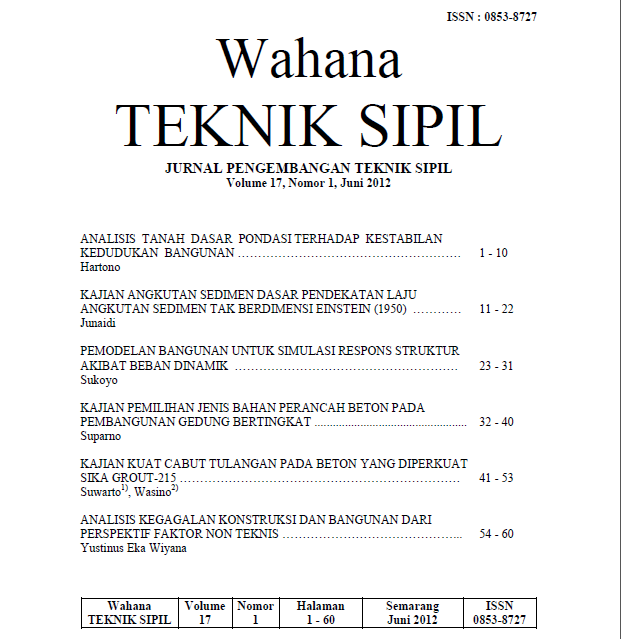Kajian Angkutan Sedimen Dasar Pendekatan Laju Angkutan Sedimen Tak Berdimensi Einstein (1950)
DOI:
https://doi.org/10.32497/wahanats.v17i1.110Keywords:
persamaan angkutan sedimen tak berdimensi, parameter angkutan, parameter aliran, grafik EinsteinAbstract
Rivers are the best sites to observe the natural effects of sediment transport. Phenomenon of sediment transport in the flow was much scrutinized by experts and some sediment transport equations have been developed. But the performance of these equations is still controversial. Gomez and Church (1989) evaluated a number of sediment transport equations were developed for flows with a gravel base and find that none who have a good consistent performance. This paper examined the sediment transport with a case study on Krasak river in Yogyakarta. This paper intended to test the accuracy of the count by using a dimensionless sediment transport equations of Einstein (1950) on sediment transport measurements. Based on the relationship between the flow parameters (Ψ) and the transport parameter (Φ) of this study compared to the graph of Einstein (1950), it appeared that some of the research data plot was fairly spread. In the plot of data with σ = 2.00 to 4.00, the trend of the data deviated far enough above the curve of Einstein. In the plot of data with σ = 1.35 to 2.00 and σ = 4.00 to 5.00; trends in the data were slightly above the curve of Einstein. While the data with σ = 1.06 to 1.35 trends to follow the curve of Einstein. This last data has a coefficient σ closed to uniform.
Downloads
Published
Issue
Section
License
Authors who publish with this journal agree to the following terms:Authors retain copyright and grant the journal right of first publication with the work simultaneously licensed under a Creative Commons Attribution License that allows others to share the work with an acknowledgement of the work's authorship and initial publication in this journal.
Authors are able to enter into separate, additional contractual arrangements for the non-exclusive distribution of the journal's published version of the work (e.g., post it to an institutional repository or publish it in a book), with an acknowledgement of its initial publication in this journal.
Authors are permitted and encouraged to post their work online (e.g., in institutional repositories or on their website) prior to and during the submission process, as it can lead to productive exchanges, as well as earlier and greater citation of published work (See The Effect of Open Access).






